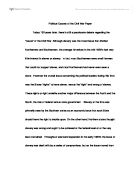Even though the South were to some extent justified to secede after Lincolns election, they would find it hard to allocate blame to many more people than themselves. Lincoln's election in 1860 was as much due to the internal dissolution of the Democrat Party as was to do with Republican policy and election campaigns. The inability of the Democrats to decide on a single candidate, which would carry votes not only in the South but also in the North, meant that both Democrats and the South were doomed from the start of the election campaign. The southern vote was split immediately and the inevitability of widespread Republican voting the North meant that the South began thinking about secession before the election result was announced. This is proved by many southern states not even including Lincoln on the ballot paper. One could claim it was because they felt it was pointless, or more cynically, because the South could then claim with more legitimacy that they were being ruled by a completely foreign government. The exclusion of Lincoln from many ballot papers, however, could be used as evidence when arguing the case that secession was inevitable after Lincoln's election.
In contrast to this argument, one could claim that Lincoln's attitudes and policies after wining the election of 1860 gave further fuel to secessionist arguments. After his election, Lincoln became very politically quiet and refused to make further comment. He did not make any public speeches or appearances in the South (nor did he in his election campaign) in order to try and reassure the Southerners that he wasn't going to oppress them. Lincoln, after his election, simply told the people to read his speeches and they would answer any questions they might have.
The question however of 'how did secession lead to civil war' is at the very heart of this title and the supposed inevitability of Civil War after secession is also disputed.
After the original 7 states seceded it became obvious to these Confederate members that just 7 states could not generate an economy as prosperous as that of the Union. This was because of the fact that the Confederacy had only 5% of the Union's industrial capacity. The entirety of this economic problem was that unless the upper 8 states joined the Confederacy, or at least Virginia, there was no way the Confederacy would be nearly as economically powerful as the Union. As a result of this, the chances were that the remaining southern states in the Union would not want to join the Confederacy and the people of the Confederacy would realise their economic decline and begin to put pressure on the Confederacy to rejoin the Union.
The politics of 1861 had moved slightly away from debate of slave ownership and more towards north and south trying to convince the upper 8 southern states to remain in or leave the Union respectively. Both north and south realised that any excessive conflict over secession could lead to the upper south making a definite decision. It was for this reason that the confrontation of Fort Sumter was so potent and probably the most important catalyst of Civil War in 1861.
After Lincoln's election but before Buchanan left office, Buchanan made the decision not to defend any arsenals, forts and general federally owned structures in the seceded states in order not to antagonise the Confederate members. However Buchanan did make one vital decision - not to withdraw the Federal garrisons at Fort Sumter and Fort Pickens.
Fort Sumter very quickly became the subject of conflict as it was situated in the centre of Charleston Harbour, South Carolina. It became a point of honour for Lincoln to defend and Davis to lay claim to it. Sumter was seen as a symbol of sovereignty for both north and south and how the two sides settled this dispute was seen as a possible deciding factor as to whether any of the 8 upper south states seceded.
The debate in Lincoln's cabinet was whether or not to re-arm or simply just re-supply Sumter. Re-arming, in Lincoln's mind, was out of the question as states such as Virginia would see it as an attack on the south and withdraw from the Union. If Lincoln simply re-supplied the Fort he thought that was justifiable. However, Davis had given orders to his general Beauregard to invade Sumter if Lincoln didn't surrender. Lincoln didn’t surrender and as ordered Beauregard attacked the fort. No one was killed but Lincoln's delegate Anderson surrendered and marched his troops back to Washington.
The main problem facing the two sides was that neither could back down once the problem had been escalated. Lincoln could not, as a new President, withdraw from a Federal owned fort; it would be seen as immense weakness in the face of opposition. Similarly, Davis could not allow a Federal owned fort to sit in the middle of a Confederate harbour. Davis could not claim complete sovereign power whilst the Confederacy were still effectively occupied by Union forces.
Could the military confrontation at Sumter been avoided? Possibly. But it would have meant one of the two sides stepping down; and after the escalation of sectional confrontation over the previous 40 years, neither side would have been prepared to do this.
The consequence of the fighting at Sumter was that Lincoln issued a call to arms, as did Davis. Virginia, vitally for the south, sided with their 'southern brothers' and seceded from the Union, as did Arkansas and North Carolina. Although support for the Confederacy was not overwhelming in these new members of the Confederacy, it was the popular decision.
Once all the states had chosen their side, a call to arms had been issued and a Union blockade enforced on the Confederacy, civil war had effectively broken out.







